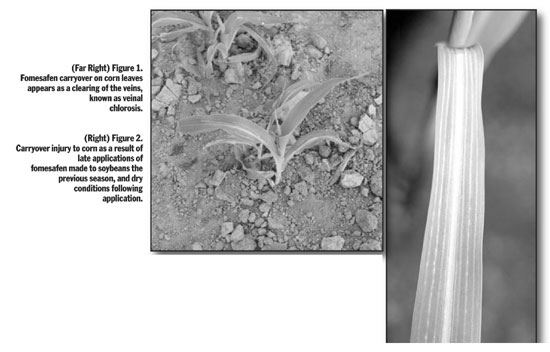Watch Out For Carryover
COLUMBIA, MO.
One thing corn growers
should probably be
aware of and look out for
this spring is carryover injury
from applications of herbicides
that contain fomesafen. Fomesafen
is the active ingredient in
the herbicides Dawn, Flexstar,
Prefix, Rhythm, and a variety of
other generic products, and in recent years has become
one of the most common active ingredients
applied post-emergence for the control of
glyphosate-resistant waterhemp in soybean.
Of the herbicides that we typically apply postemergence
in soybeans, fomesafen is one of the
most persistent and has
one of the longest periods
of soil residual activity. Because
of this soil persistence
as well as the sensitivity of corn to fomesafen
residues, the label of most fomesafen products like
Flexstar and Prefix requires a 10-month rotational
interval between fomesafen applications and corn
planting.
There are two primary factors that influence the
likelihood of fomesafen carryover injury to corn; 1)
dry conditions following application, and 2) the rate
and timing of the herbicide application.
Although most areas of the state received near
average levels of precipitation during the fall and
winter, there are some regions that have had below
average levels of rainfall and snow during this same
time period. Under especially dry conditions, the
risk of fomesafen carryover injury to corn is much
higher. Soil moisture is critically important for herbicide
degradation. If adequate rainfall is not received
after application, then the chemical and
microbial processes responsible for herbicide
degradation are reduced significantly and the herbicide
molecules are more likely to become bound
(adsorbed) to soil particles. All of this results in less
herbicide degradation and increases the likelihood
of herbicide carryover. Injury may also be more noticeable
on sandy soils, as these areas are usually
better drained and hold moisture for shorter periods
of time.

The rate and the timing of the fomesafen application
are two other factors that influence the likelihood
of carryover injury to corn. Simply put,
the higher the rate of fomesafen applied and the
later the herbicide application was made, the
greater the chance that some fomesafen may remain
to cause carryover injury to corn. Since the
labels of most fomesafen-containing products require
a 10-month rotational interval between application
and corn planting, late-season
applications of these products in soybeans and
early planting of corn the following spring can often
make satisfying these intervals difficult.
The most common corn injury symptom caused
by fomesafen carryover is a whitening of the leaf
veins, commonly referred to as veinal chlorosis
(Figures 1 and 2). Affected areas of corn leaves
often take on a
striped appearance,
can become
necrotic, and tissue
near the leaf
midrib may totally
collapse in that region.
The root system of affected plants usually remains
normal.
What does all of this mean for growers who are
planning to plant corn in an area that received applications
of fomesafen last year? I think it means
that corn growers should be more aware of the
higher potential for herbicide carryover injury that
can occur, especially in areas that have experienced
dry fall and winter conditions, or in fields
that received late or higher amounts of fomesafen
than usual. The best practice is to follow the rotational
intervals listed on the labels of the herbicides
used and to consider the herbicide use history of
each field in relation to the factors discussed above.
If several of these factors suggest a high probability
of fomesafen carryover, then it's probably a good
idea to stay away from corn in these fields during
the 2012 growing season. Δ
DR. KEVIN BRADLEY: Associate Professor, Division
of Plant Sciences, University of Missouri